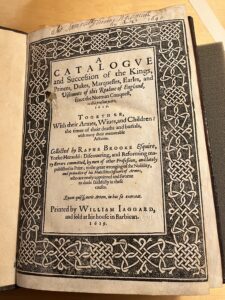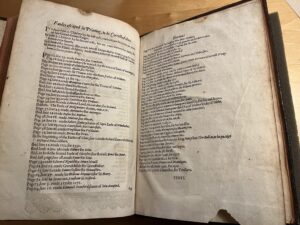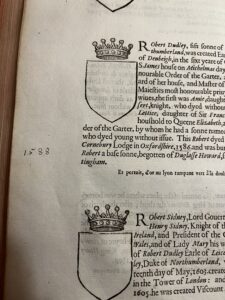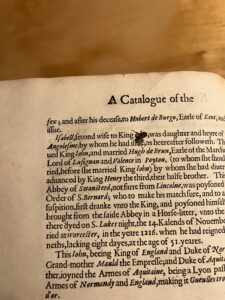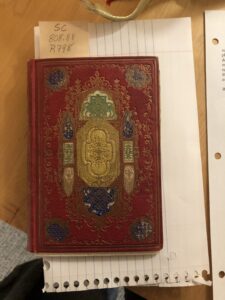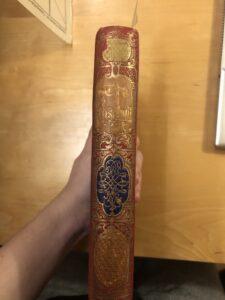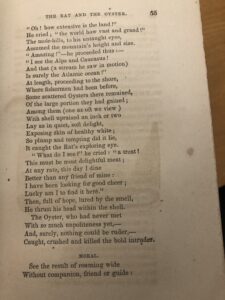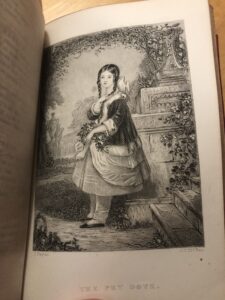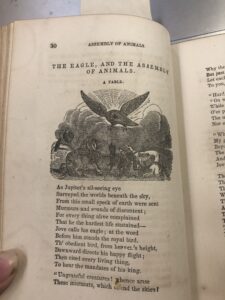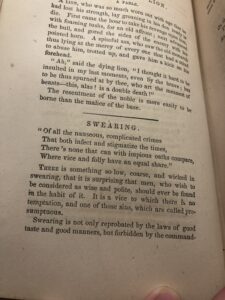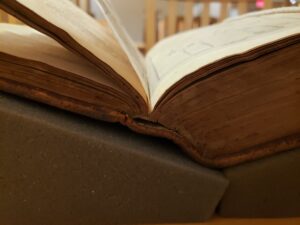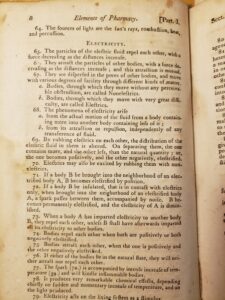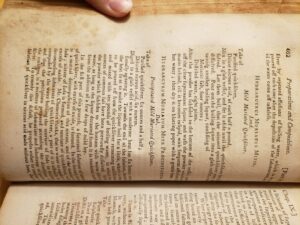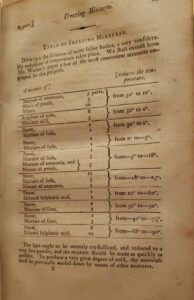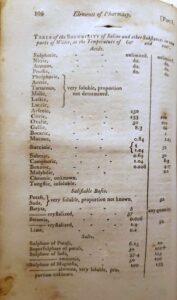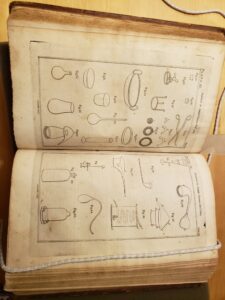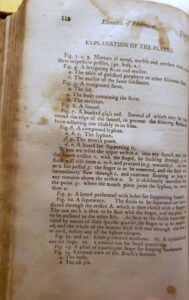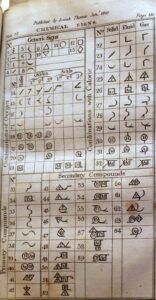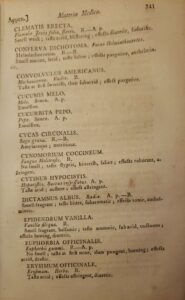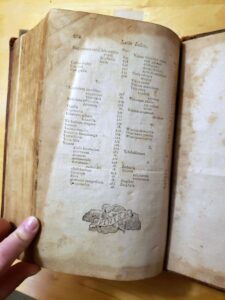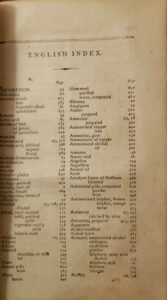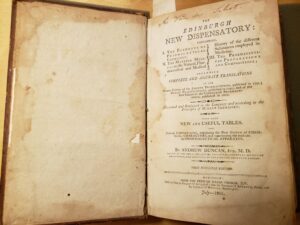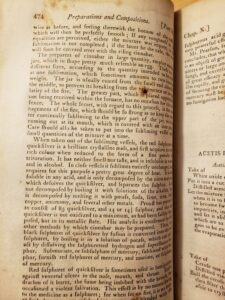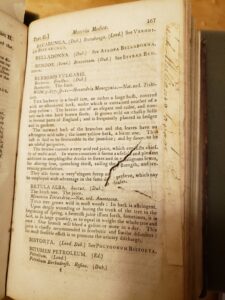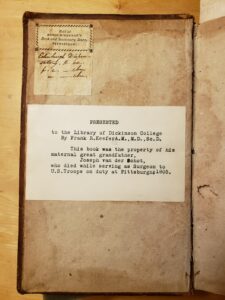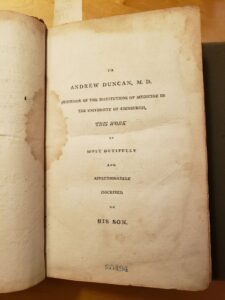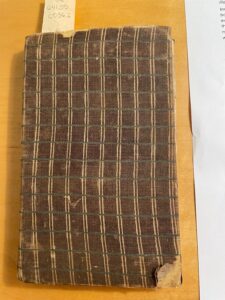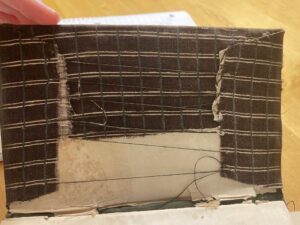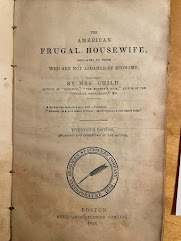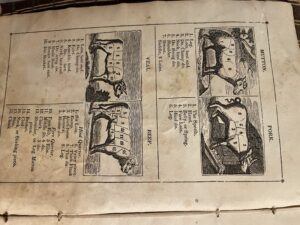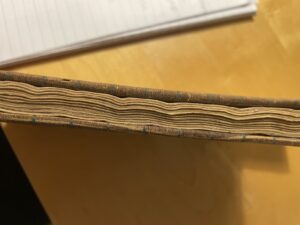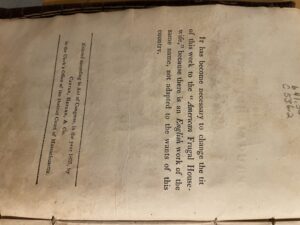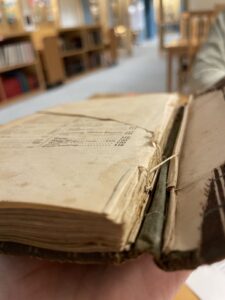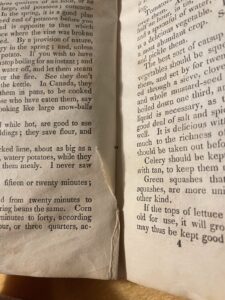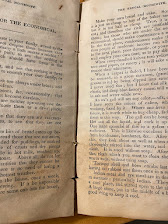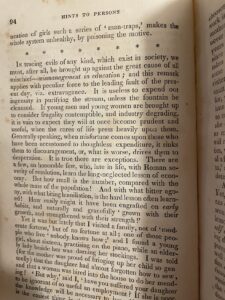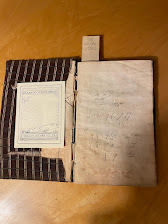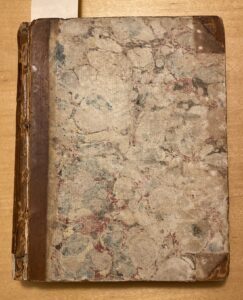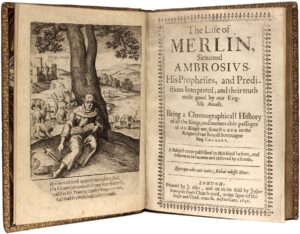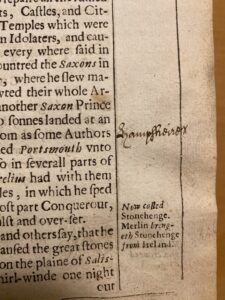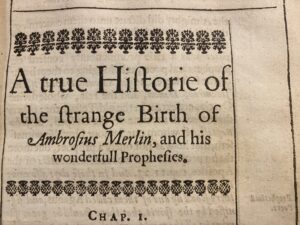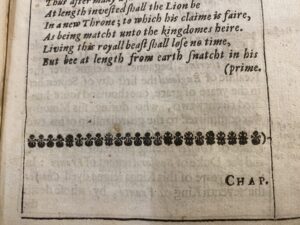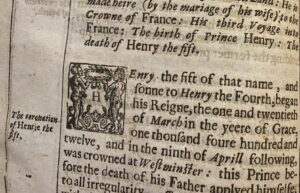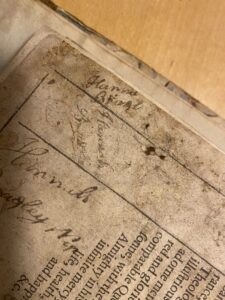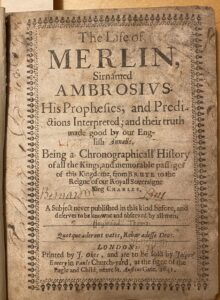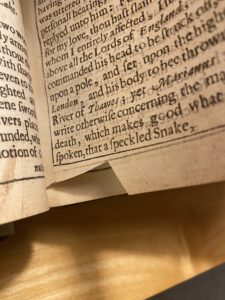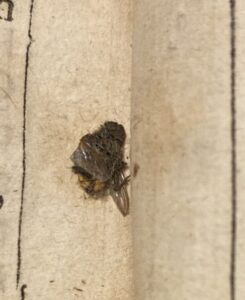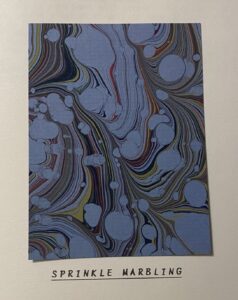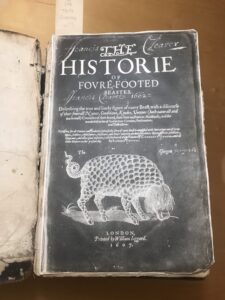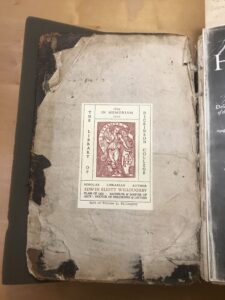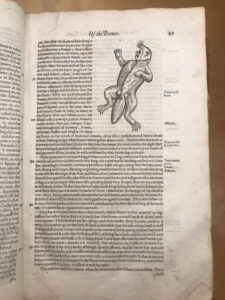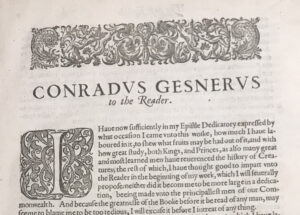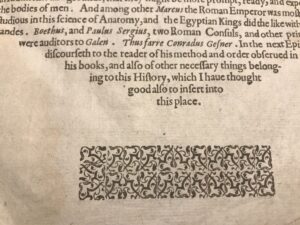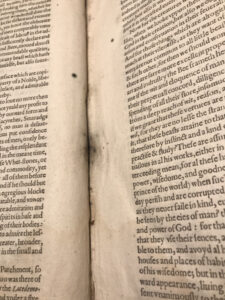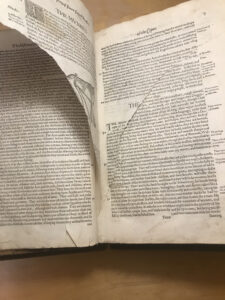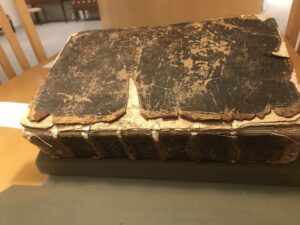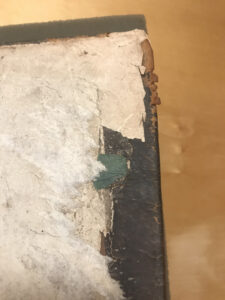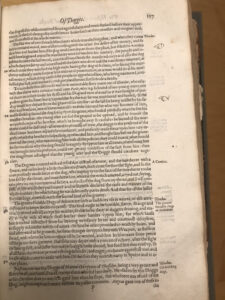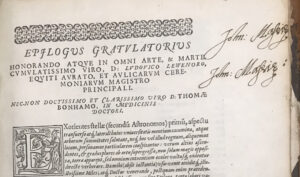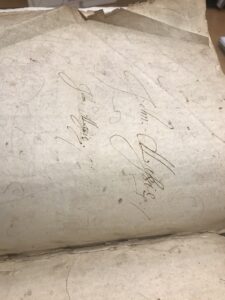
Moby Dick by Herman Melville is widely considered one of the greatest American novels, renowned for its complex allusions and thoughtful prose. The 1979 Arion Press edition of Moby-Dick; or, the Whale stands out not just for its literary brilliance, but for the fine craftsmanship of the physical book. The copy of the classic in the Dickinson archives’ possession is referred to as the Deluxe California Edition, which contains photographic representations of the original content of the primary 1979 production. However, the fact that these pages are copies does not detract from the aesthetic value of the work. While the original edition was considerably rare with 265 editions, there are 750 copies of the California deluxe and trade editions in collections and archives (Moby Dick or, the whale, www.ucpress.edu). I chose this particular book to intimately study because it is a familiar story that has taken on an interesting new physical form. The book stands out for its significant size, with the cover spanning 14 by 9 ¾ inches. Although this size is reduced from the initial version, it creates a more accessible and convenient text by making it less expensive and easier to read. The compressed size allows the reader to hold it in their hands, and the large text is convenient for reading. I also found it intriguing that this book appeared to be unread and unused, sparking my curiosity to dive deeper into its history despite its relatively short history.
The introductory note by James D. Hart identifies the typeface to be 18-point Goudy Modern, which was designed in 1918 (“Goudy Modern”). Additionally, the aptly named Leviathan font is used for the titling capitals and large blue drop caps at the beginning of each chapter. This font was designed specifically for the Arion Press edition of Moby Dick by Charles Bigelow and Kris Holmes — this is clearly an example of the deliberate attention to detail regarding the connection between the presentation of the book and the literary content. This thread of continuity is also represented in the deep ocean blue color of the text, mimicking the aesthetic of Moby Dick.
In the brilliant title page, the reader is greeted with a meticulously detailed woodcut portrait of Herman Melville, set askew from the title of the work in a large, powerful font. The title is in the Leviathan, consistent with the beginning of each subsequent chapter. Underneath the title, the signature portrays the history of this book’s journey to Dickinson College. In 2002, Friends of the Library purchased Moby-Dick; or, the Whale to display the works of their guest speaker of the year, Barry Moser. His signature artfully transforms into an arrow or harpoon, following the style of the book. The publisher name is centered at the bottom of the page,
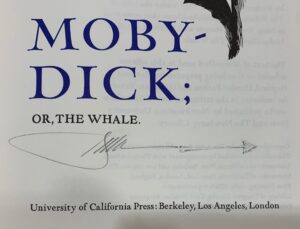
Although the creator of the signature is unclear in the book, I examined Barry Moser’s signatures on other works and reasoned that he signed this copy when he visited.
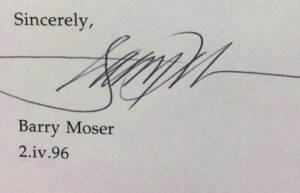
Finding out the person behind the signature was like an unfurling mystery, encouraging me to look at people with connections to the book and examine trails of evidence.
along with Melville’s dedication and declaration of admiration for his dear friend Nathaniel Hawthorne on the next page (Phillips). Also prior to the beginning of the text, an etymology explores the origins of the word whale — setting up the scene for the blend of history and fiction in the work.
Additionally, an extract incorporates Melville’s comical excerpt from a sub-sub librarian to demonstrate simultaneously his sense of humor and knowledge of whale references. He details the carelessness of the “librarians’” collection of quotes from notable literary works that mention the sea creatures; in fact, he is commenting on the notion that the reader will not appreciate all of the work he put into this collection by deeming the librarian somewhat incompetent. This front matter ironically generates a jovial mood that is contradicted by the relatively somber atmosphere of the literature’s content. Moreover, an elaborate map exhibits the somewhat convoluted route the famous Pequod took, bringing the story to life. After the story is completed, this book features a colophon that provides information regarding the publication of Moby-Dick; or, the Whale, making the fine details of the publication of the book clearly accessible to the public.
Furthermore, the book is ornamented with 100black and white images, each enhancing the reading experience by providing contextual clues and aesthetic adornments to the writing. The illustrations are intricate woodcut engravings created by the previously mentioned Barry Moser, known for his dazzli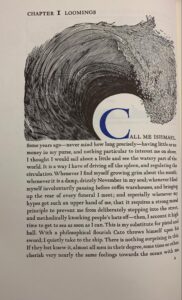 ng engravings spotlighted in works such as Dante’s Inferno and a vividly detailed King James Bible (“A Brief History of Pennyroyal Press”). One can see the texture of the engravement, detailed by small slashes and stark contrasts between ink and paper. James D. Hart asserts that primary characters are never illustrated to allow the readers to imagine their faces — instead, technical depictions of boats and whales are sprinkled throughout the text (“A Note on the California Edition”). Notably, the famous first line of Moby Dick is amplified by the dramatic illustration of a monumental wave that skillfully incorporates the curvature of the first letter C, marrying the text and the artwork.
ng engravings spotlighted in works such as Dante’s Inferno and a vividly detailed King James Bible (“A Brief History of Pennyroyal Press”). One can see the texture of the engravement, detailed by small slashes and stark contrasts between ink and paper. James D. Hart asserts that primary characters are never illustrated to allow the readers to imagine their faces — instead, technical depictions of boats and whales are sprinkled throughout the text (“A Note on the California Edition”). Notably, the famous first line of Moby Dick is amplified by the dramatic illustration of a monumental wave that skillfully incorporates the curvature of the first letter C, marrying the text and the artwork.
Additionally, the binding is an interesting combination of sewing and adhesive along the spine. The glue is the primary source of keeping the book intact, while the stitching holds the pages together. The book also has a visible light blue and white thread headband that accentuates the silver lettering stamped on the exterior smooth spine. The unadorned cover of the book is made out of a Moroccan blue buckram cloth, mimicking the goatskin of the original edition of the book. The endpaper marking the front and back of the book is also a rich shade of dark blue, which is contrasted by the paper constituting the book.
The paper is remarkably high quality, described as “dampened handmade paper by platen letterpress” in the introductory passage, “ANote on the California Edition”. The pages are thick, heavy yet flexible, slightly yellow, loud when flipped, and smooth to the touch. The edges of the pages are very precisely cut and laid out in a reader-friendly format. Page numbers are located at the bottom left-hand corner, being the only other material on the page other than text or images. It is also important to note that the beginning of a new chapter does not signify a new page — instead, there is a small amount of space before the title of the new chapter and drop cap. Interestingly, there are 609 pages in the physical book, yet only 576 of them contain Melville’s story. A handful of the remaining pages are dedicated to front matter (title page, extracts, table of contents, publication information, etc.) and the colophon, yet a significant portion of the remaining pages are left starkly blank.
Overall, the book seems to be in pristine condition. There are no apparent signs of usage, and the physical book has been maintained beautifully. However, the slipcase did demonstrate slight signs of use, discoloration, and fraying. When examining this book, I felt as though I was holding a valuable work of art. The attention to even the most minute details in this work was impeccable, in turn creating a masterpiece of a physical book.

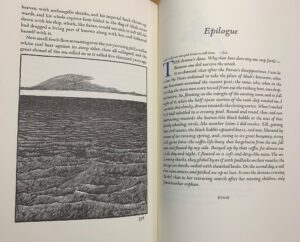
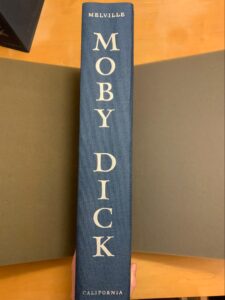
Works Cited
“A Brief History of Pennyroyal Press.” Barry Moser-Pennyroyal Press, https://www.moser-pennyroyal.com/brief-history.
“About Arion Press.” Arion Press, https://www.arionpress.com/arion-about.
“Artist & Illustrator Barry Moser Autographed Typed Letter, Signed by the Author!” Worthpoint, https://www.worthpoint.com/worthopedia/artist-illustrator-barry-moser-1844097006.
“Goudy Modern in Use.” Fonts in Use, https://fontsinuse.com/typefaces/47/goudy-modern.
Greenfield, Jane. ABC OF BOOKBINDING: An Unique Glossary with over 700 Illustrations for Collectors & Librarians. Oak Knoll Press, 1998.
Melville Herman et al. Moby-Dick or the Whale. Arion Press 1979.
“Moby-Dick by Herman Melville, Illustrated by Barry Moser, Arion Press, 1979.” Classic Editions, https://www.classiceditions.com/moby-dick-by-herman-melville-illustrated-by-barry-moser-arion-press-1979/.
“Moby-Dick, or, The Whale.” OCLC WorldCat.org, https://www.worldcat.org/.
“Moby Dick or, the Whale.” University of California Press, https://www.ucpress.edu/book/9780520045484/moby-dick-or-the-whale.
Phillips, John. “Melville Meets Hawthorne.” American Heritage, 1 Feb. 2023, https://www.americanheritage.com/melville-meets-hawthorne.
